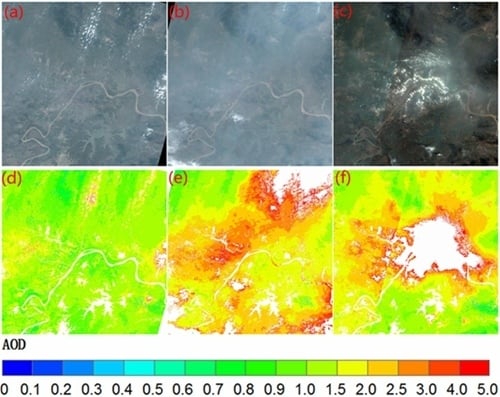High Resolution Aerosol Optical Depth Retrieval Using Gaofen-1 WFV Camera Data
Abstract
:1. Introduction
2. Study Area and Datasets
2.1. Study Area
2.2. Datasets
2.2.1. Gaofen-1 Wide-Field-of-View (GF-1 WFV) Data
2.2.2. Moderate-Resolution Imaging Spectroradiometer (MODIS) Aerosol Optical Depth (AOD) Data
2.2.3. Ground Measurements
3. AOD Retrieval Algorithm
3.1. Aerosol Optical Properties over Wuhan
3.2. Surface Reflectance Determination
4. Results and Discussion
4.1. Retrieved Results from the Proposed Algorithm
4.2. Comparison of GF-1 WFV AOD with MODIS AOD
4.3. Comparison of GF-1 WFV AOD with Ground Measurements
4.4. Performance and Limitations of the Proposed Algorithm
5. Conclusions
Acknowledgments
Author Contributions
Conflicts of Interest
References
- Haywood, J.; Boucher, O. Estimates of the direct and indirect radiative forcing due to tropospheric aerosols: A review. Rev. Geophys. 2000, 38, 513–543. [Google Scholar] [CrossRef]
- Kaufman, Y.J.; Tanre, D.; Boucher, O. A satellite view of aerosols in the climate system. Nature 2002, 419, 215–223. [Google Scholar] [CrossRef] [PubMed]
- Sun, Y.; Wang, Z.; Wild, O.; Xu, W.; Chen, C.; Fu, P.; Du, W.; Zhou, L.; Zhang, Q.; Han, T.; et al. “APEC Blue”: Secondary aerosol reductions from emission controls in Beijing. Sci. Rep. 2016, 6, 20668. [Google Scholar] [CrossRef] [PubMed]
- Mishchenko, M.I.; Geogdzhayev, I.V.; Cairns, B.; Carlson, B.E.; Chowdhary, J.; Lacis, A.A.; Liu, L.; Rossow, W.B.; Travis, L.D. Past, present, and future of global aerosol climatologies derived from satellite observations: A perspective. J. Quant. Spectrosc. Radiat. Transf. 2007, 106, 325–347. [Google Scholar] [CrossRef]
- Yang, J.; Gong, P.; Fu, R.; Zhang, M.; Chen, J.; Liang, S.; Xu, B.; Shi, J.; Dickinson, R. The role of satellite remote sensing in climate change studies. Nat. Clim. Chang. 2013, 3, 875–883, Erratum in 2014, 4, 74. [Google Scholar] [CrossRef]
- Holben, B.; Vermote, E.; Kaufman, Y.J.; Tanré, D.; Kalb, V. Aerosol retrieval over land from AVHRR data-application for atmospheric correction. IEEE Trans. Geosci. Remote Sens. 1992, 30, 212–222. [Google Scholar] [CrossRef]
- Remer, L.A.; Kaufman, Y.; Tanré, D.; Mattoo, S.; Chu, D.; Martins, J.V.; Li, R.-R.; Ichoku, C.; Levy, R.; Kleidman, R. The MODIS aerosol algorithm, products, and validation. J. Atmos. Sci. 2005, 62, 947–973. [Google Scholar] [CrossRef]
- Lee, K.H.; Li, Z.; Kim, Y.J.; Kokhanovsky, A. Atmospheric aerosol monitoring from satellite observations: A history of three decades. In Atmospheric and Biological Environmental Monitoring; Springer: Heidelberg, Germany, 2009; pp. 13–38. [Google Scholar]
- Sun, L.; Sun, C.K.; Liu, Q.H.; Zhong, B. Aerosol optical depth retrieval by HJ-1/CCD supported by MODIS surface reflectance data. Sci. China Earth Sci. 2010, 53, 74–80. [Google Scholar] [CrossRef]
- Ma, Z.; Hu, X.; Sayer, A.M.; Levy, R.; Zhang, Q.; Xue, Y.; Tong, S.; Bi, J.; Huang, L.; Liu, Y. Satellite-based spatiotemporal trends in PM2.5 concentrations: China, 2004–2013. Environ. Health Perspect. 2016, 124, 184–192. [Google Scholar] [CrossRef] [PubMed]
- Tao, M.; Chen, L.; Su, L.; Tao, J. Satellite observation of regional haze pollution over the North China Plain. J. Geophys. Res. Atmos. 2012, 117. [Google Scholar] [CrossRef]
- Omar, A.H.; Won, J.G.; Winker, D.M.; Yoon, S.C.; Dubovik, O.; McCormick, M.P. Development of global aerosol models using cluster analysis of Aerosol Robotic Network (AERONET) measurements. J. Geophys. Res. Atmos. 2005, 110. [Google Scholar] [CrossRef]
- Li, C.; Lau, A.; Mao, J.; Chu, D. Retrieval, Validation, and Application of the 1-km Aerosol Optical Depth from MODIS Measurements over Hong Kong. IEEE Trans. Geosci. Remote Sens. 2005, 43, 2650–2658. [Google Scholar]
- Kaufman, Y.J.; Wald, A.E.; Remer, L.A.; Gao, B.-C.; Li, R.-R.; Flynn, L. The MODIS 2.1-μm channel-correlation with visible reflectance for use in remote sensing of aerosol. IEEE Trans. Geosci. Remote Sens. 1997, 35, 1286–1298. [Google Scholar] [CrossRef]
- Levy, R.C.; Remer, L.A.; Mattoo, S.; Vermote, E.F.; Kaufman, Y.J. Second-generation operational algorithm: Retrieval of aerosol properties over land from inversion of Moderate Resolution Imaging Spectroradiometer spectral reflectance. J. Geophys. Res. Atmos. 2007, 112. [Google Scholar] [CrossRef]
- Kaufman, Y.J.; Tanré, D.; Remer, L.A.; Vermote, E.F.; Chu, A.; Holben, B.N. Operational remote sensing of tropospheric aerosol over land from EOS moderate resolution imaging spectroradiometer. J. Geophys. Res. Atmos. 1997, 102, 17051–17067. [Google Scholar] [CrossRef]
- Liang, S.; Fallah-Adl, H.; Kalluri, S.; JáJá, J.; Kaufman, Y.J.; Townshend, J.R.G. An operational atmospheric correction algorithm for Landsat Thematic Mapper imagery over the land. J. Geophys. Res. Atmos. 1997, 102, 17173–17186. [Google Scholar] [CrossRef]
- Gillingham, S.; Flood, N.; Gill, T.; Mitchell, R. Limitations of the dense dark vegetation method for aerosol retrieval under Australian conditions. Remote Sens. Lett. 2012, 3, 67–76. [Google Scholar] [CrossRef]
- Santer, R.; Ramon, D.; Vidot, J.; Dilligeard, E. A surface reflectance model for aerosol remote sensing over land. Int. J. Remote Sens. 2007, 28, 737–760. [Google Scholar] [CrossRef]
- Nichol, J.E.; Wong, M.S.; Chan, Y.Y. Fine resolution air quality monitoring from a small satellite: CHRIS/PROBA. Sensors 2008, 8, 7581–7595. [Google Scholar] [CrossRef] [PubMed]
- Wang, Z.; Chen, L.; Gong, H.; Gao, H. Modified DDV method of aerosol optical depth inversion over land surfaces from CBERS02B. J. Remote Sens. 2009, 13, 1047–1059. [Google Scholar]
- Munchak, L.; Levy, R.; Mattoo, S.; Remer, L.; Holben, B.; Schafer, J.; Hostetler, C.; Ferrare, R. MODIS 3 km aerosol product: Applications over land in an urban/suburban region. Atmos. Meas. Tech. 2013, 6, 1747–1759. [Google Scholar] [CrossRef]
- Levy, R.C.; Remer, L.A.; Kleidman, R.G.; Mattoo, S.; Ichoku, C.; Kahn, R.; Eck, T.F. Global evaluation of the Collection 5 MODIS dark-target aerosol products over land. Atmos. Chem. Phys. 2010, 10, 10399–10420. [Google Scholar] [CrossRef]
- Hsu, N.C.; Gautam, R.; Sayer, A.M.; Bettenhausen, C.; Li, C.; Jeong, M.J.; Tsay, S.C.; Holben, B.N. Global and regional trends of aerosol optical depth over land and ocean using SeaWiFS measurements from 1997 to 2010. Atmos. Chem. Phys. 2012, 12, 8037–8053. [Google Scholar] [CrossRef]
- Hsu, N.C.; Tsay, S.-C.; King, M.D.; Herman, J.R. Deep blue retrievals of Asian aerosol properties during ACE-Asia. IEEE Trans. Geosci. Remote Sens. 2006, 44, 3180–3195. [Google Scholar] [CrossRef]
- Hsu, N.; Jeong, M.J.; Bettenhausen, C.; Sayer, A.; Hansell, R.; Seftor, C.; Huang, J.; Tsay, S.C. Enhanced deep blue aerosol retrieval algorithm: The second generation. J. Geophys. Res. Atmos. 2013, 118, 9296–9315. [Google Scholar] [CrossRef]
- Lee, J.; Kim, J.; Song, C.H.; Ryu, J.; Ahn, Y.; Song, C.K. Algorithm for retrieval of aerosol optical properties over the ocean from the Geostationary Ocean Color Imager. Remote Sens. Environ. 2010, 114, 1077–1088. [Google Scholar] [CrossRef]
- Guo, J.P.; Zhang, X.Y.; Wu, Y.R.; Zhaxi, Y.; Che, H.Z.; La, B.; Wang, W.; Li, X.W. Spatio-temporal variation trends of satellite-based aerosol optical depth in China during 1980–2008. Atmos. Environ. 2011, 45, 6802–6811. [Google Scholar] [CrossRef]
- Lu, Z.; Zhang, Q.; Streets, D.G. Sulfur dioxide and primary carbonaceous aerosol emissions in China and India, 1996–2010. Atmos. Chem. Phys. 2011, 11, 9839–9864. [Google Scholar] [CrossRef]
- Cheng, H.; Gong, W.; Wang, Z.; Zhang, F.; Wang, X.; Lv, X.; Liu, J.; Fu, X.; Zhang, G. Ionic composition of submicron particles (PM1.0) during the long-lasting haze period in January 2013 in Wuhan, central China. J. Environ. Sci. 2014, 26, 810–817. [Google Scholar] [CrossRef]
- Song, J.; Guang, W.; Li, L.; Xiang, R. Assessment of air quality status in Wuhan, China. Atmosphere 2016, 7, 56. [Google Scholar] [CrossRef]
- Wang, L.; Gong, W.; Xia, X.; Zhu, J.; Li, J.; Zhu, Z. Long-term observations of aerosol optical properties at Wuhan, an urban site in Central China. Atmos. Environ. 2015, 101, 94–102. [Google Scholar] [CrossRef]
- Feng, L.; Li, J.; Gong, W.; Zhao, X.Z.; Chen, X.; Pang, X. Radiometric cross-calibration of Gaofen-1 WFV cameras using Landsat-8 OLI images: A solution for large view angle associated problems. Remote Sens. Environ. 2016, 174, 56–68. [Google Scholar] [CrossRef]
- Li, J.; Chen, X.L.; Tian, L.Q.; Huang, J.; Feng, L. Improved capabilities of the Chinese high-resolution remote sensing satellite GF-1 for monitoring suspended particulate matter (SPM) in inland waters: Radiometric and spatial considerations. ISPRS J. Photogramm. Remote Sens. 2015, 106, 145–156. [Google Scholar] [CrossRef]
- Vermote, E.F.; Tanré, D.; Deuze, J.L.; Herman, M.; Morcette, J. Second simulation of the satellite signal in the solar spectrum, 6S: An overview. IEEE Trans. Geosci. Remote Sens. 1997, 35, 675–686. [Google Scholar] [CrossRef]
- Li, Z.; Niu, F.; Lee, K.; Xin, J.; Hao, W.; Nordgren, B.; Wang, Y.; Wang, P. Validation and understanding of Moderate Resolution Imaging Spectroradiometer aerosol products (C5) using ground-based measurements from the handheld Sun photometer network in China. J. Geophys. Res. Atmos. 2007, 112. [Google Scholar] [CrossRef]
- He, Q.; Li, C.; Tang, X.; Li, H.; Geng, F.; Wu, Y. Validation of MODIS derived aerosol optical depth over the Yangtze River Delta in China. Remote Sens. Environ. 2010, 114, 1649–1661. [Google Scholar] [CrossRef]
- Giles, D.M.; Holben, B.N.; Eck, T.F.; Sinyuk, A.; Smirnov, A.; Slutsker, I.; Dickerson, R.R.; Thompson, A.M.; Schafer, J.S. An analysis of AERONET aerosol absorption properties and classifications representative of aerosol source regions. J. Geophys. Res. Atmos. 2012, 117. [Google Scholar] [CrossRef]
- Russell, P.B.; Bergstrom, R.W.; Shinozuka, Y.; Clarke, A.D.; DeCarlo, P.F.; Jimenez, J.L.; Livingston, J.M.; Redemann, J.; Dubovik, O.; Strawa, A. Absorption angstrom exponent in AERONET and related data as an indicator of aerosol composition. Atmos. Chem. Phys. 2010, 10, 1155–1169. [Google Scholar] [CrossRef]
- Kim, M.; Kim, J.; Wong, M.S.; Yoon, J.; Lee, J.; Wu, D.; Chan, P.W.; Nichol, J.; Chung, C.; Ou, M. Improvement of aerosol optical depth retrieval over Hong Kong from a geostationary meteorological satellite using critical reflectance with background optical depth correction. Remote Sens. Environ. 2014, 142, 176–187. [Google Scholar] [CrossRef]
- Levy, R.; Mattoo, S.; Munchak, L.; Remer, L.; Sayer, A.; Patadia, F.; Hsu, N. The Collection 6 MODIS aerosol products over land and ocean. Atmos. Meas. Tech. 2013, 6, 2989–3034. [Google Scholar] [CrossRef]
- Wong, M.S.; Nichol, J.; Lee, K.H. An operational MODIS aerosol retrieval algorithm at high spatial resolution, and its application over a complex urban region. Atmos. Res. 2011, 99, 579–589. [Google Scholar] [CrossRef]
- Luo, N.; Wong, M.S.; Zhao, W.; Yan, X.; Xiao, F. Improved aerosol retrieval algorithm using Landsat images and its application for PM10 monitoring over urban areas. Atmos. Res. 2015, 153, 264–275. [Google Scholar] [CrossRef]
- Gupta, P.; Khan, M.N.; da Silva, A.; Patadia, F. Modis aerosol optical depth observations over urban areas in Pakistan: Quantity and quality of the data for air quality monitoring. Atmos. Pollut. Res. 2013, 4, 43–52. [Google Scholar] [CrossRef]
- Nichol, J.; Bilal, M. Validation of MODIS 3 km resolution aerosol optical depth retrievals over Asia. Remote Sens. 2016, 8, 328. [Google Scholar] [CrossRef]
- Sun, L.; Wei, J.; Bilal, M.; Tian, X.; Jia, C.; Guo, Y.; Mi, X. Aerosol optical depth retrieval over bright areas using Landsat 8 OLI images. Remote Sens. 2016, 8, 23. [Google Scholar] [CrossRef]
- Li, S.; Chen, L.; Xiong, X.; Tao, J.; Su, L.; Han, D.; Liu, Y. Retrieval of the haze optical thickness in North China Plain using MODIS data. IEEE Trans. Geosci. Remote Sens. 2013, 51, 2528–2540. [Google Scholar] [CrossRef]
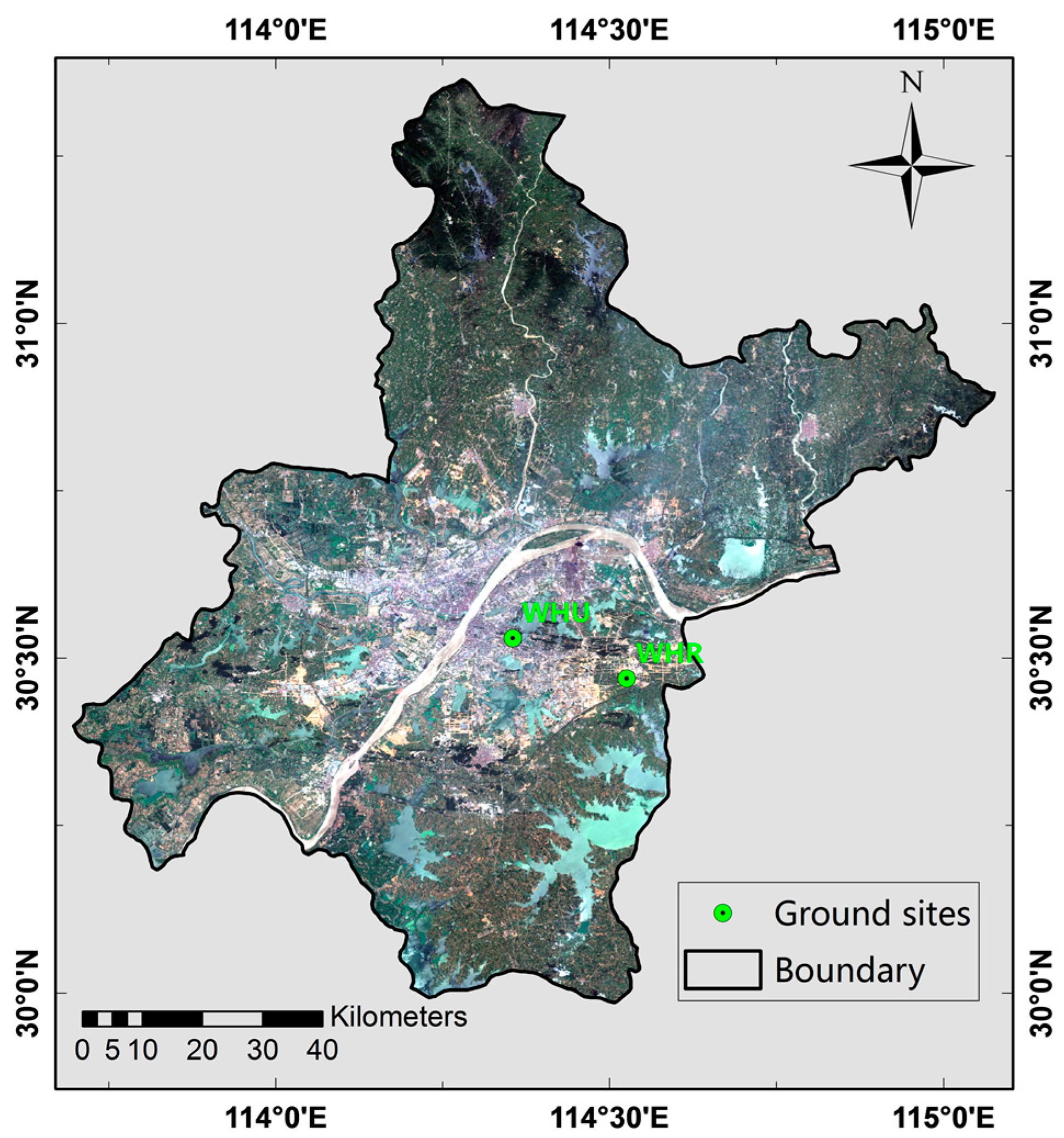
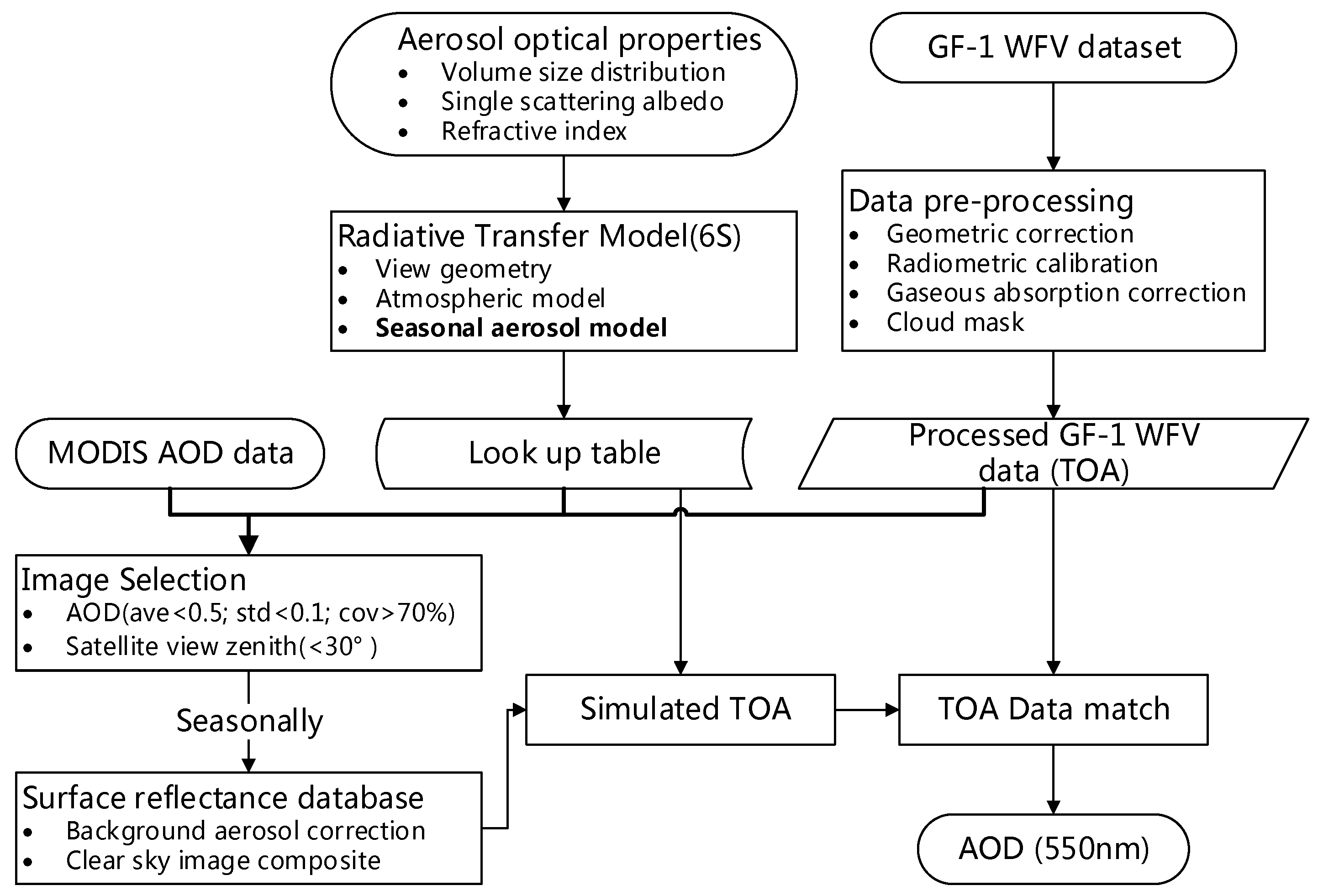
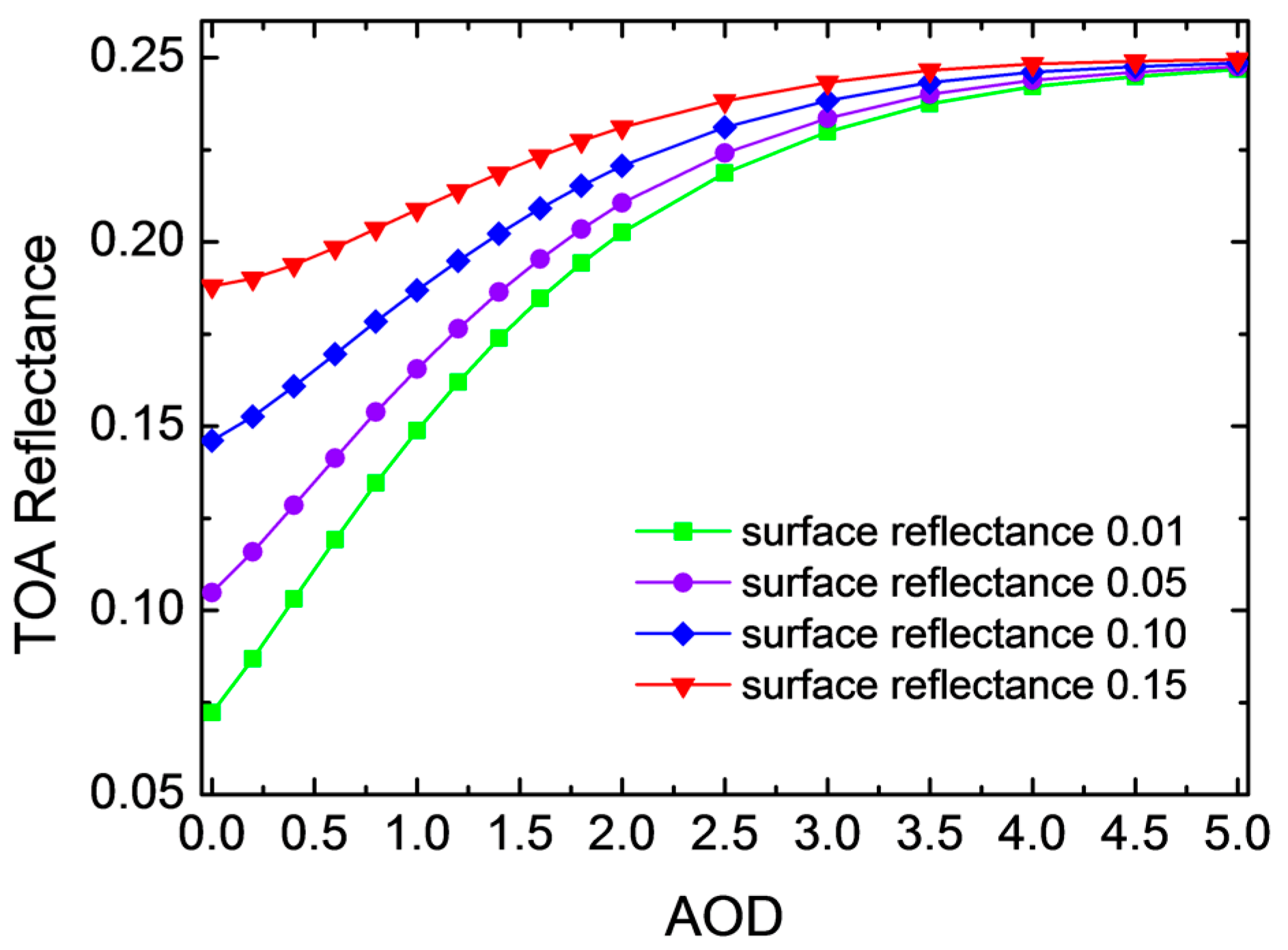
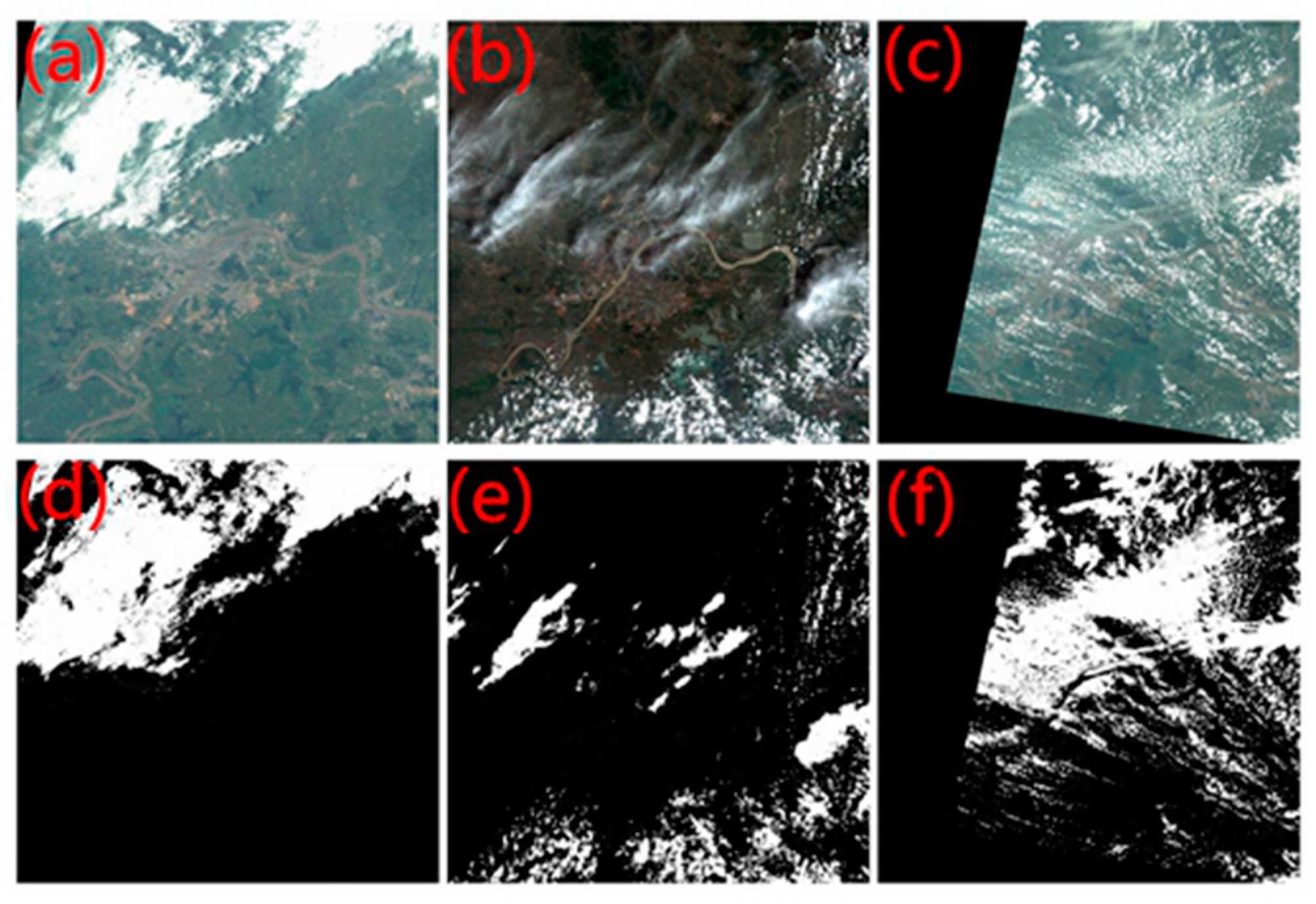
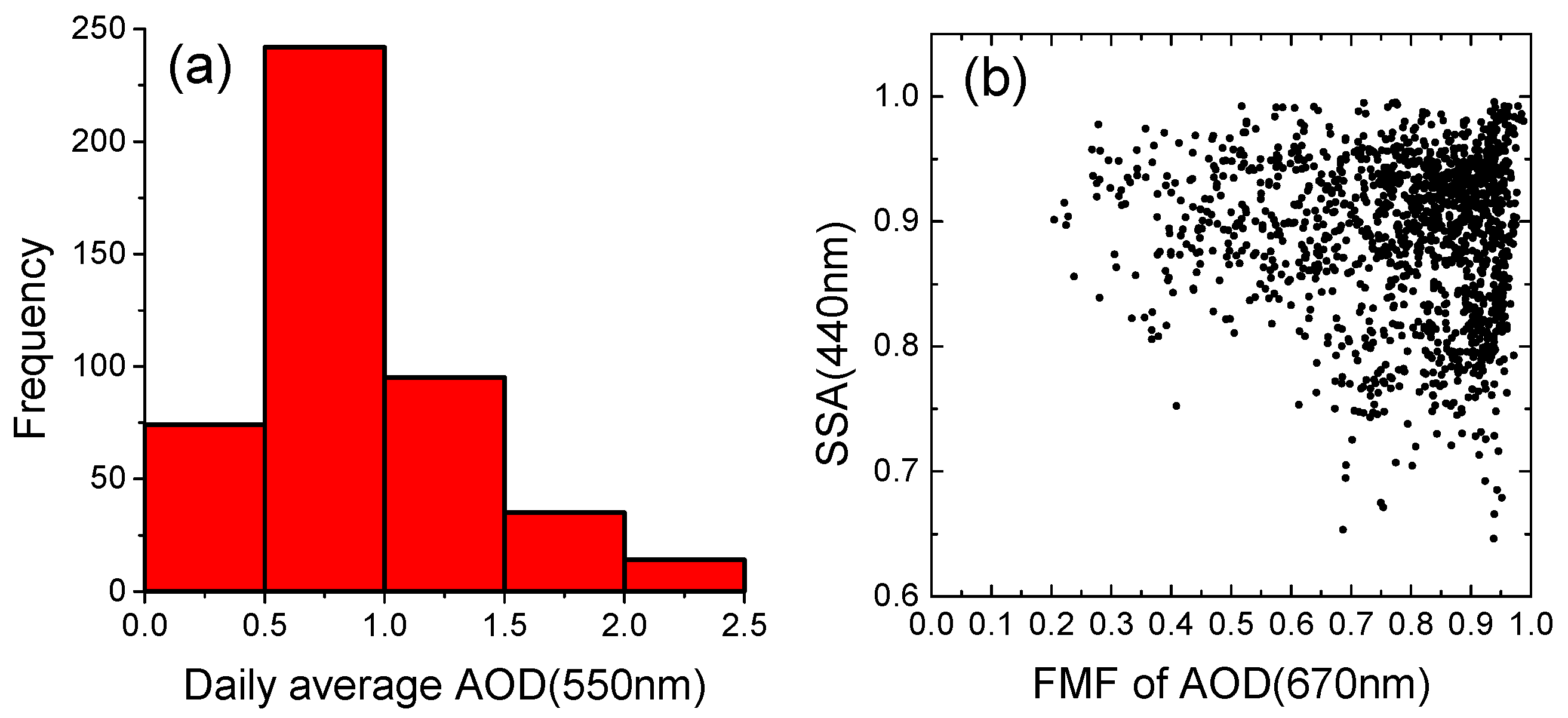
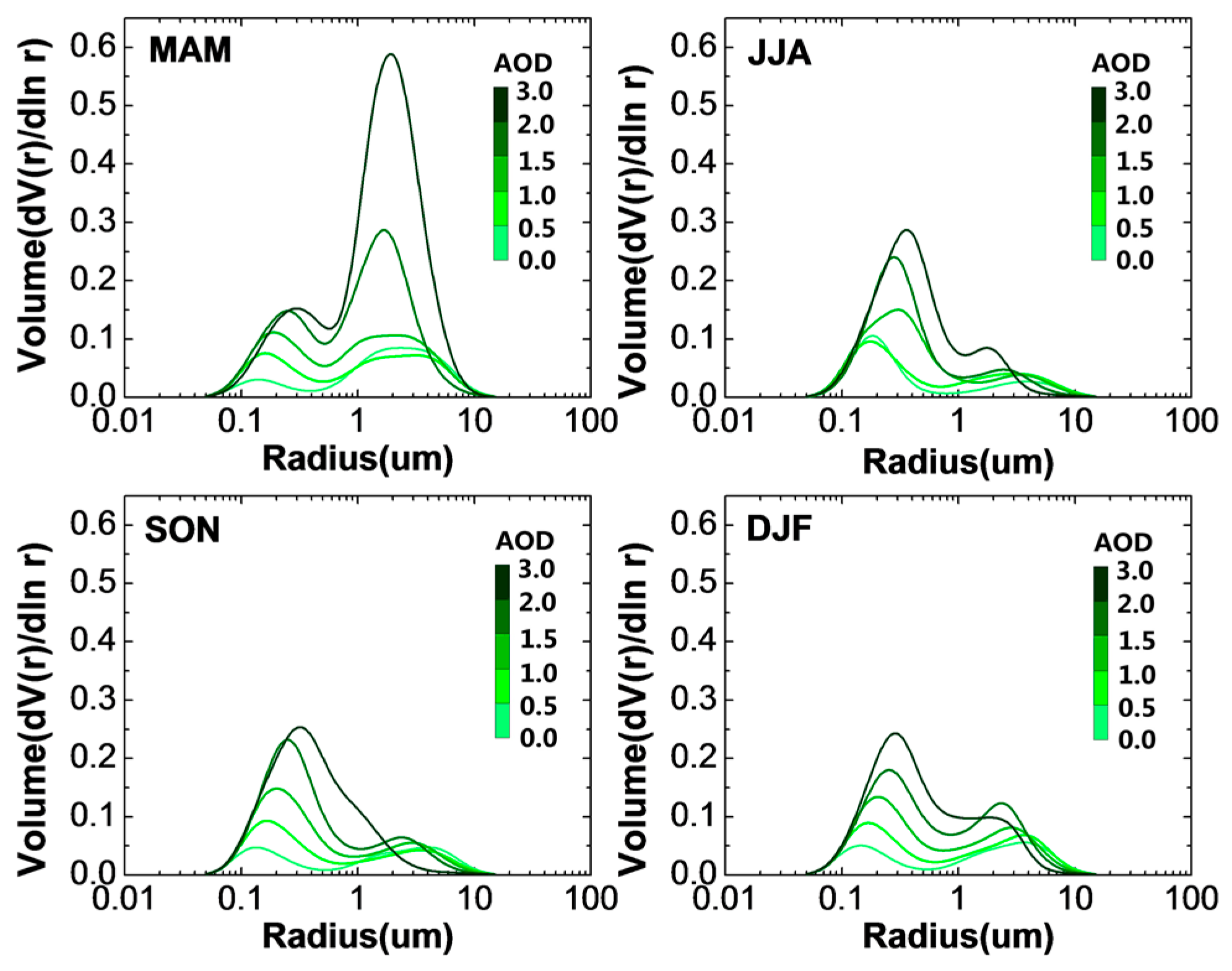
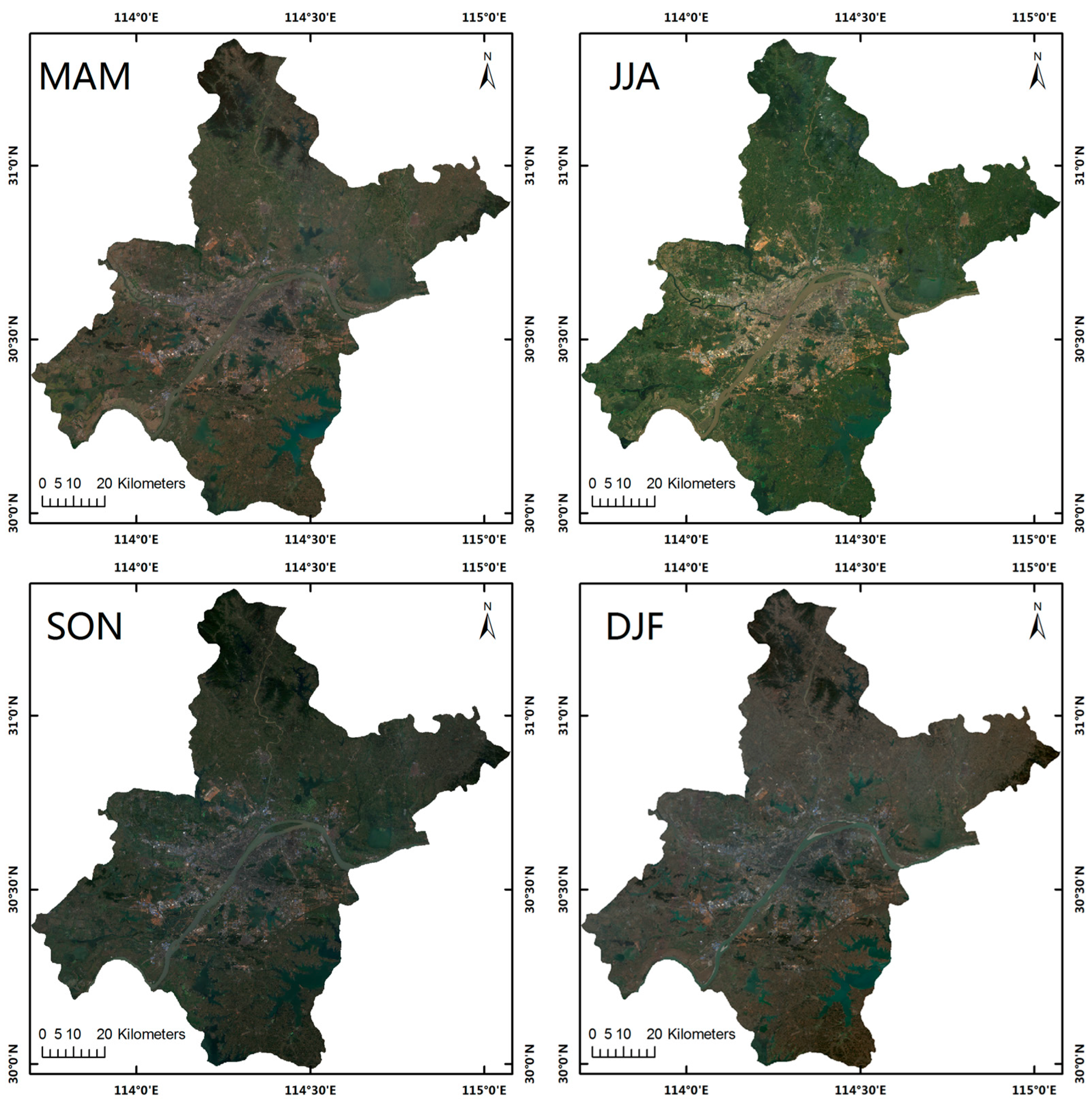
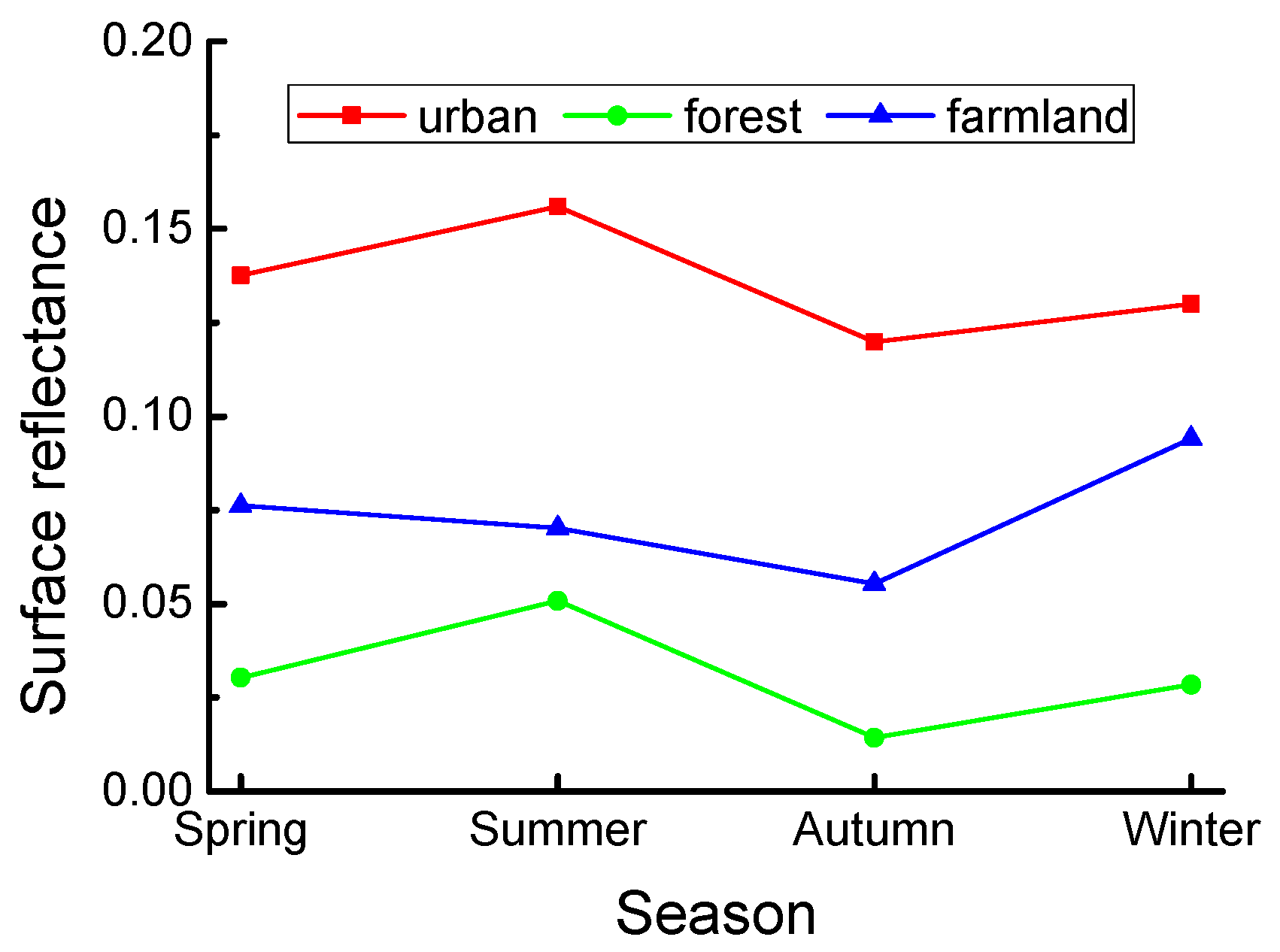
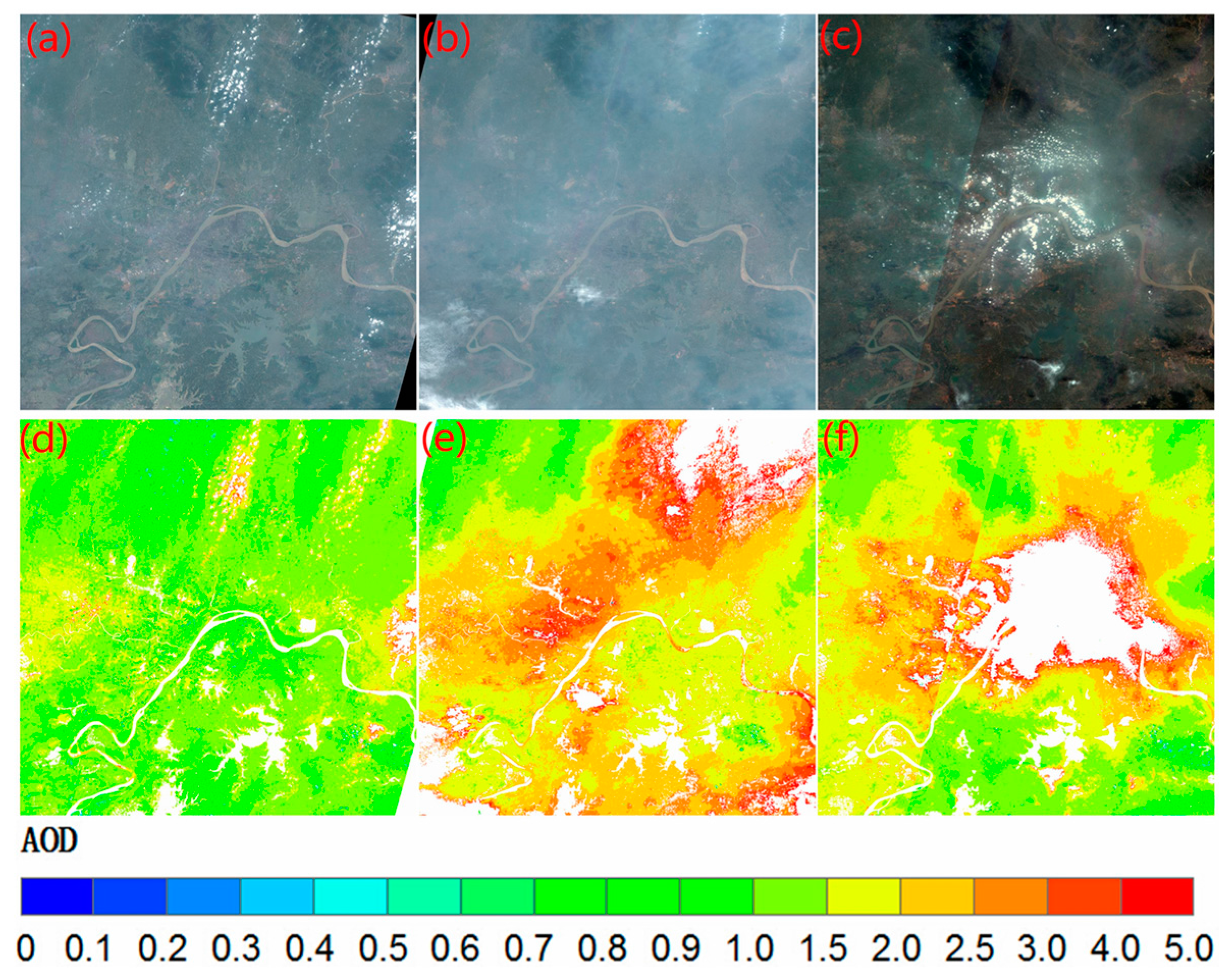
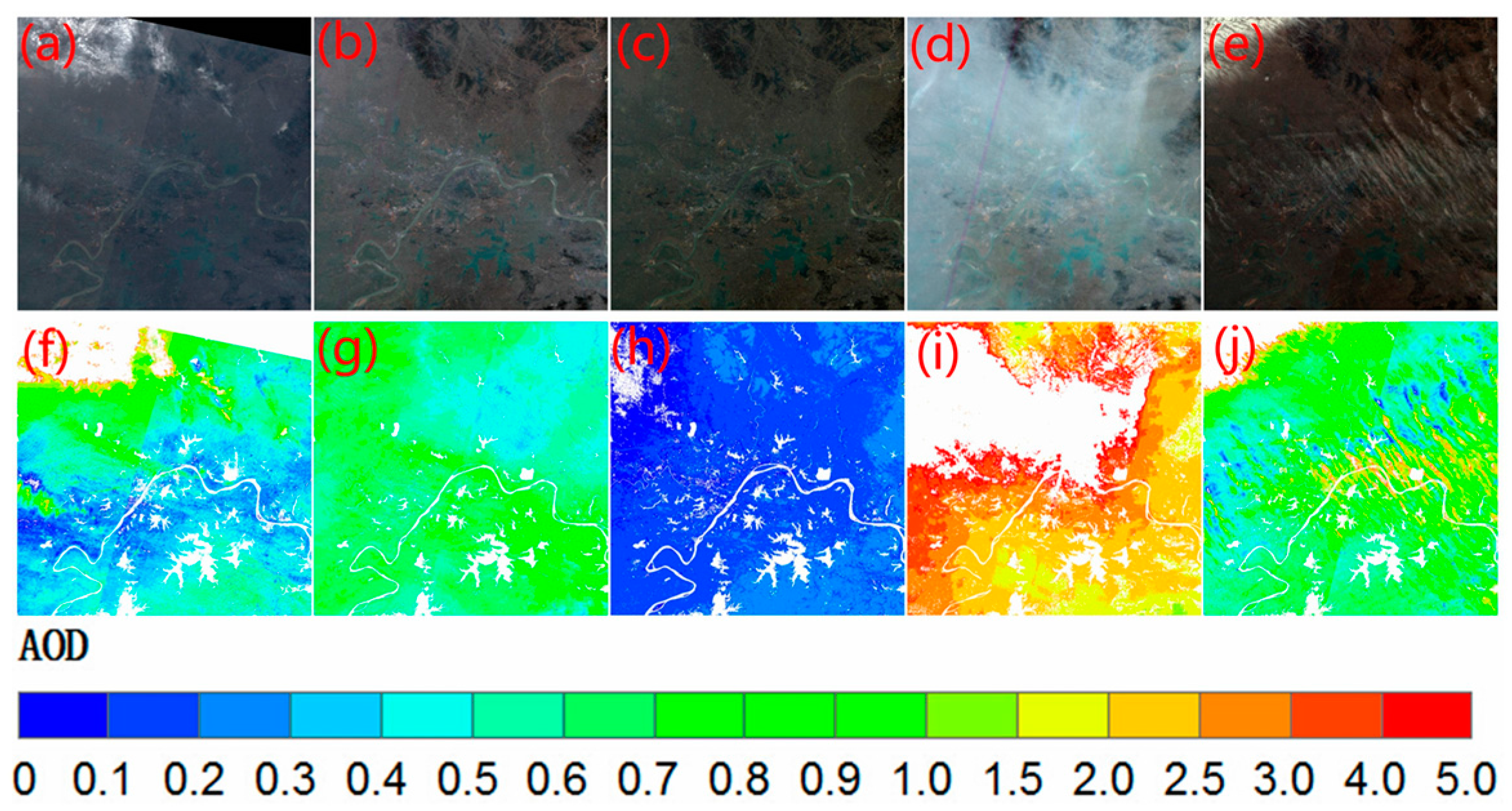
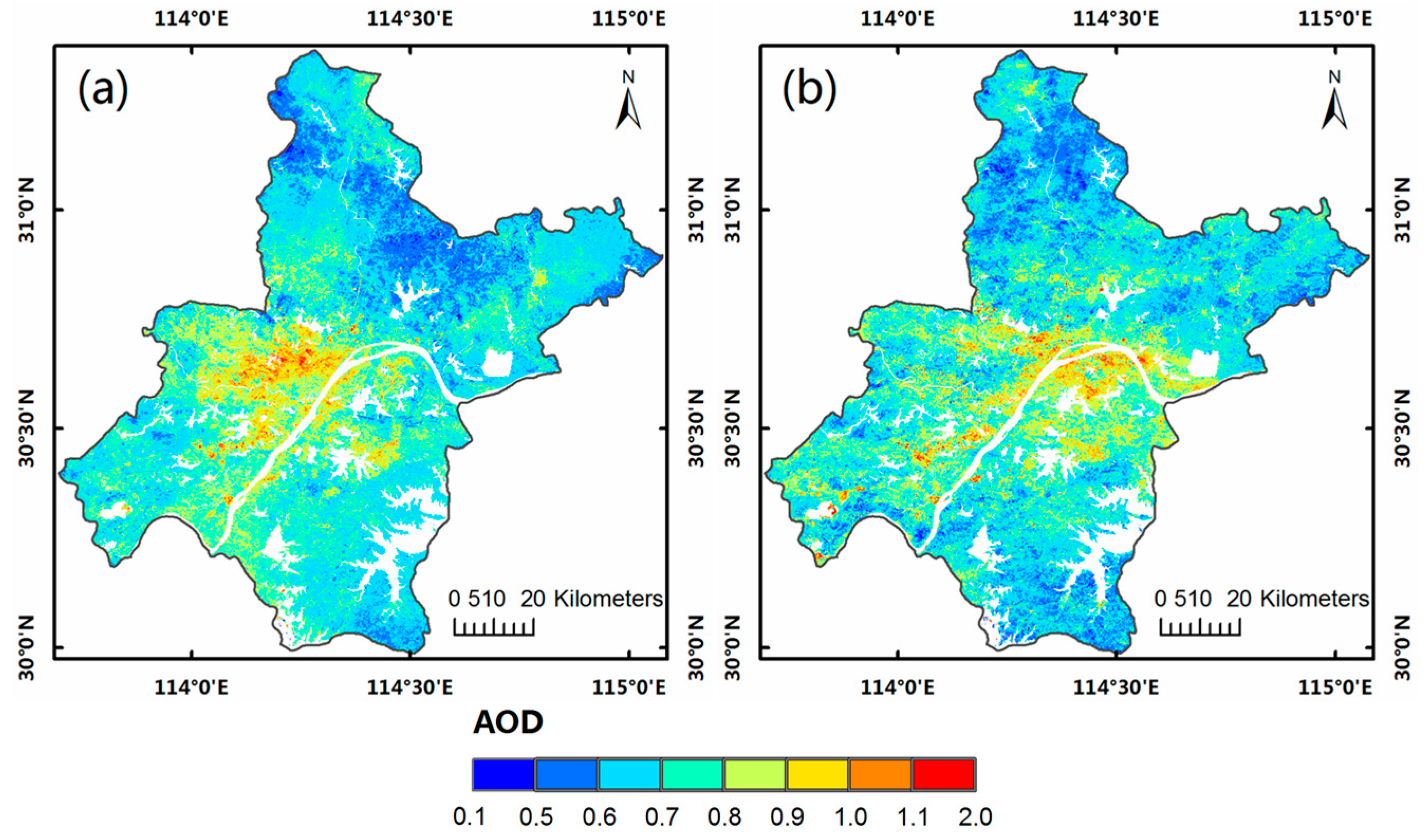
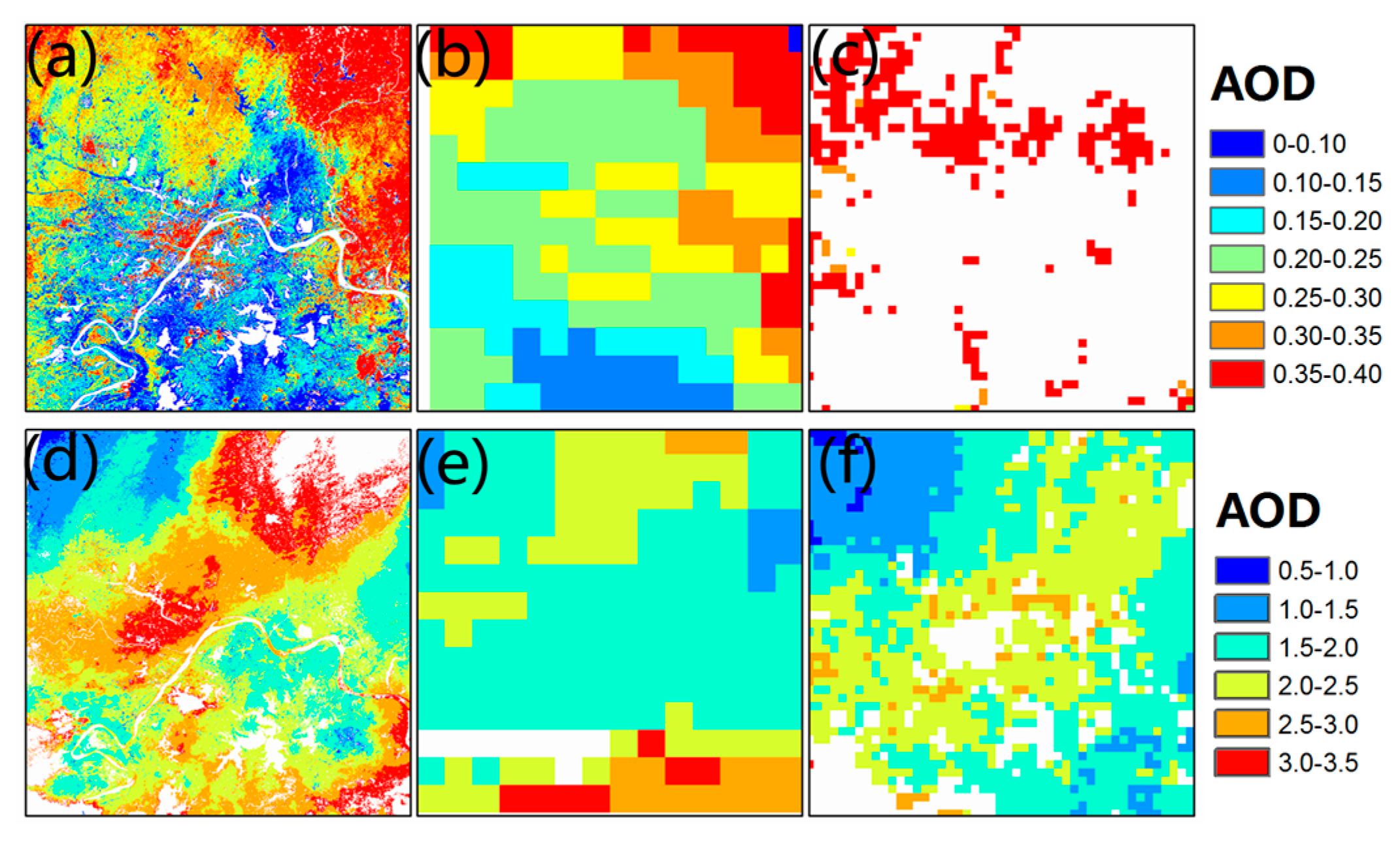
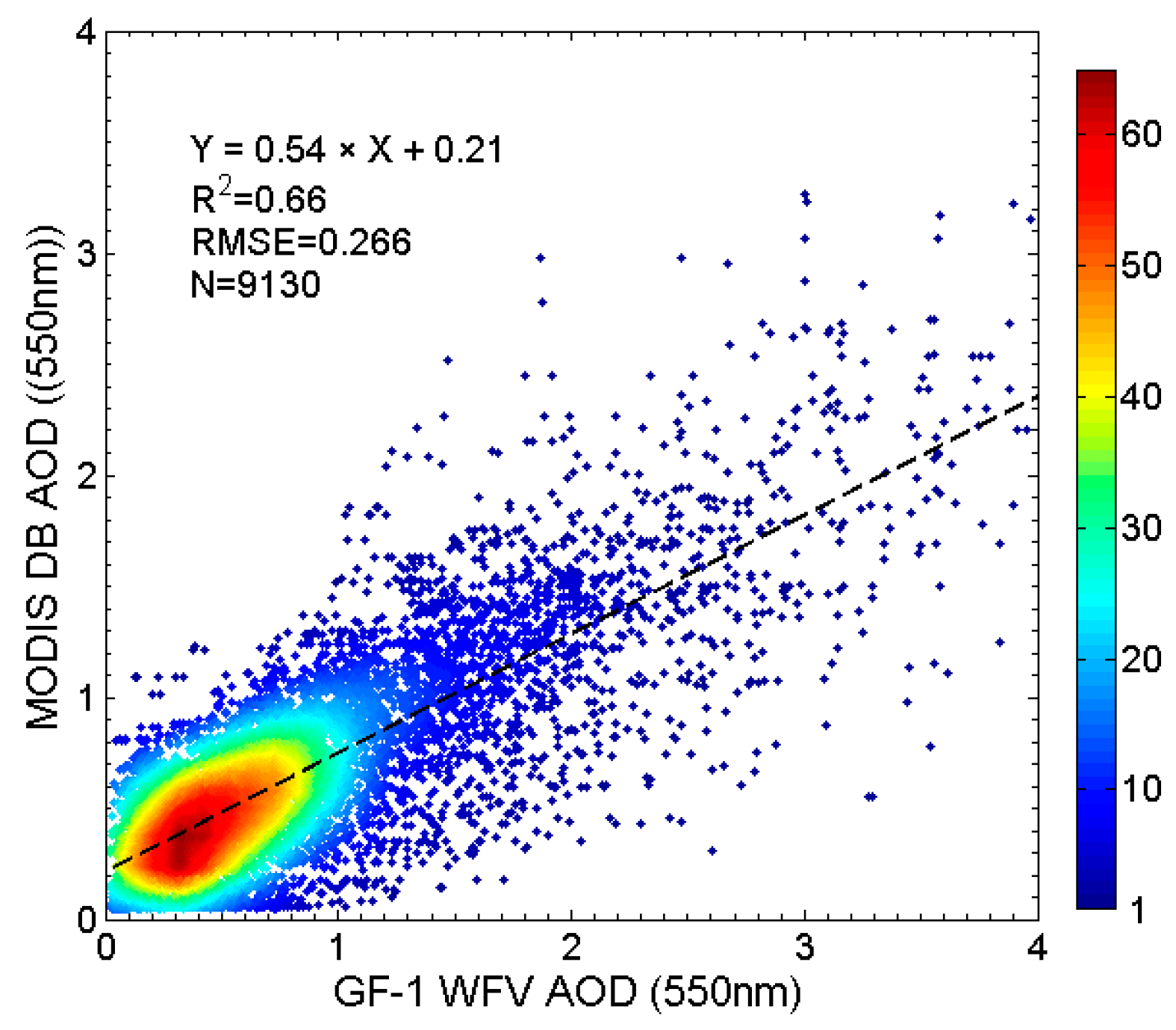
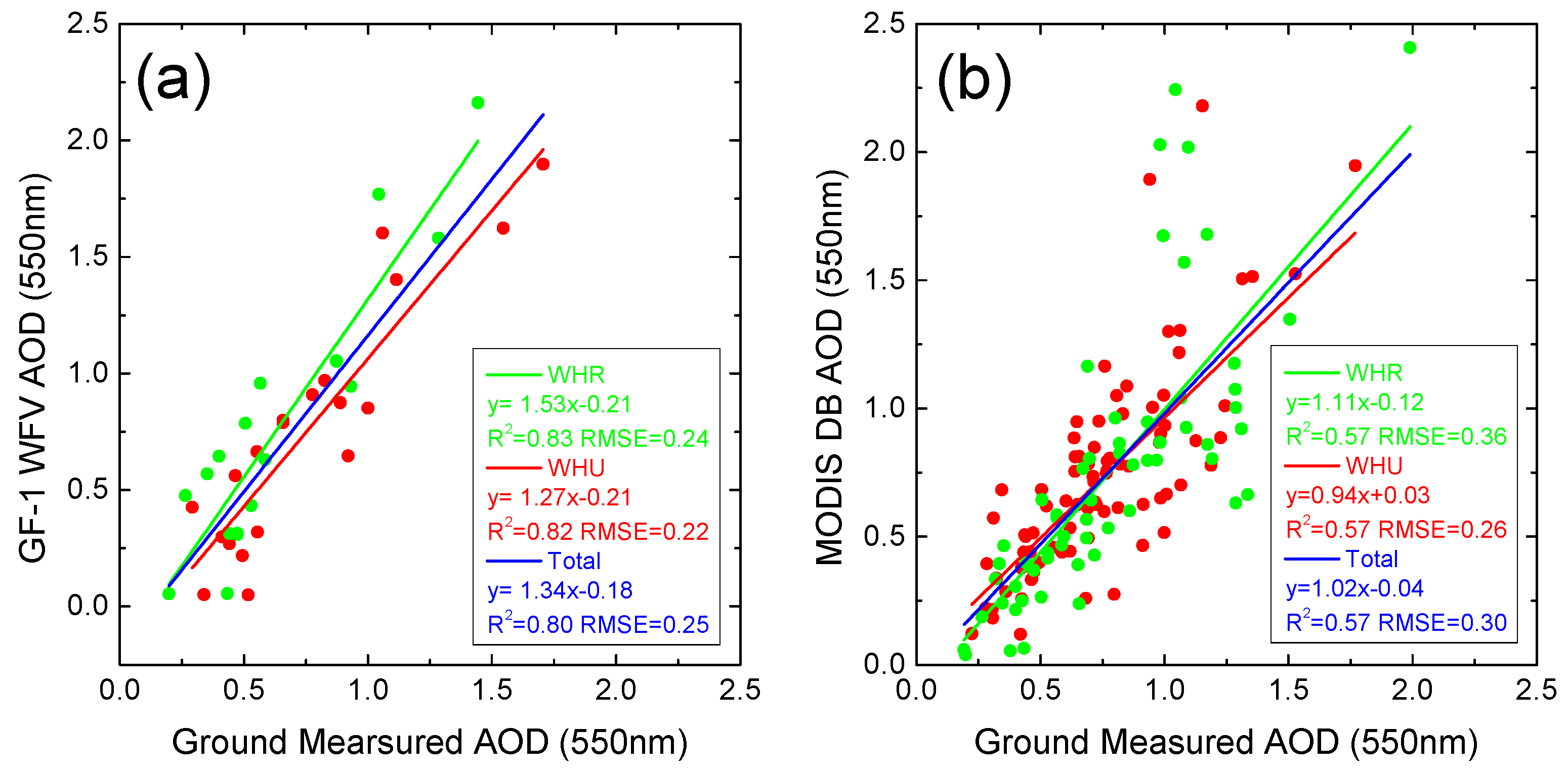
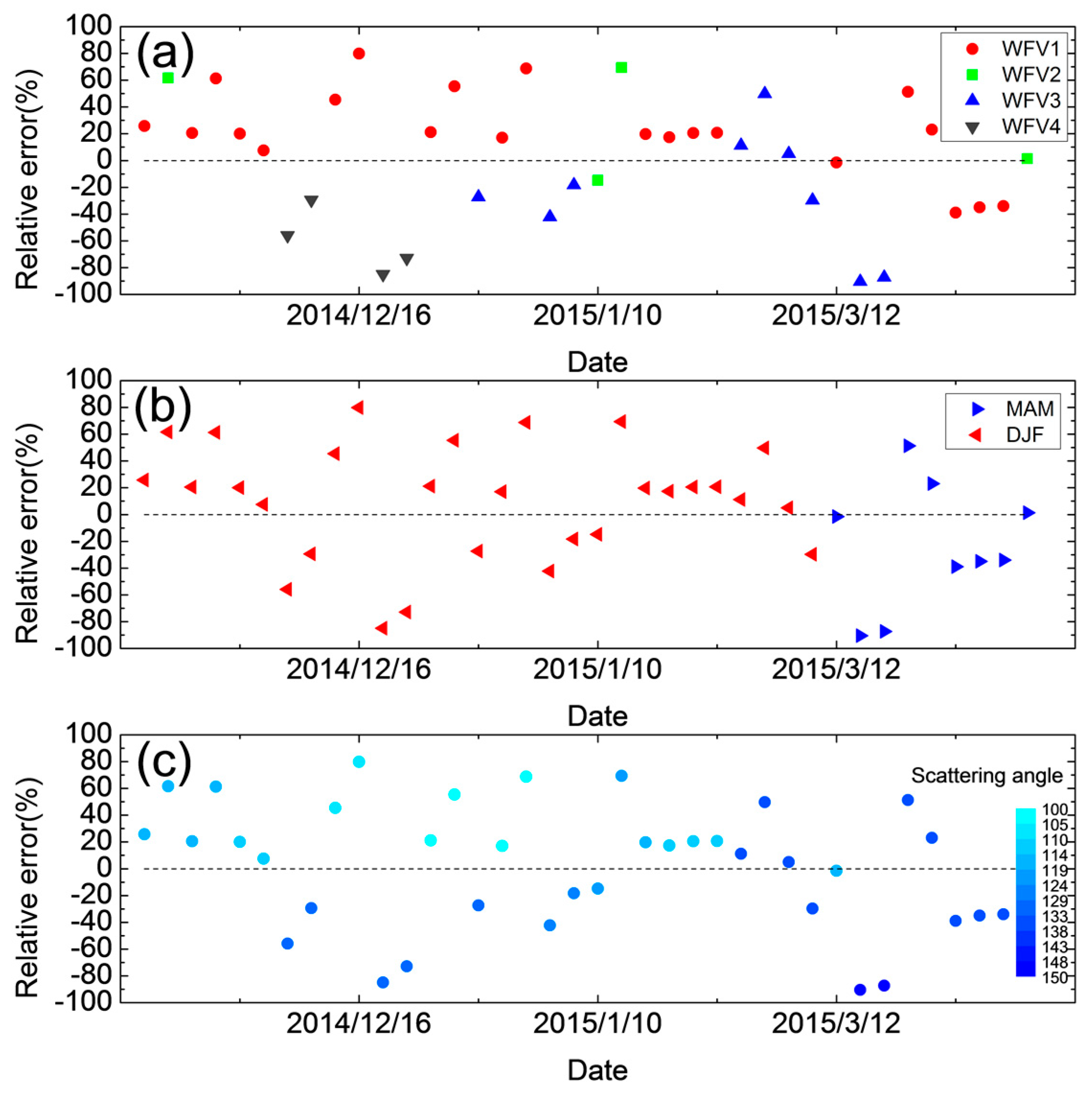
| Band | Band Range (µm) | Spatial Resolution (m) | Re-Visiting Period (Days) | Swath (km) |
|---|---|---|---|---|
| Blue | 045–0.52 | 16 | 4 | 800 |
| Green | 0.52–0.59 | |||
| Red | 0.63–0.69 | |||
| NIR | 0.77–0.89 |
| Site | Lat/Lon | Terrain | Instrument | Observing Period |
|---|---|---|---|---|
| WHU | 30°32′N, 114°21′E | Urban | CE-318 | 2008–2012; December 2014–June 2015 |
| WHR | 30°28′N, 114°32′E | Rural | MICROTOPS-II | December 2014–June 2015 |
| Input Variables | No. of Entries | Entries |
|---|---|---|
| SZA | 14 | 0, 6, 12, …, 78 |
| VZA | 14 | 0, 6, 12, …, 78 |
| RAA | 16 | 0, 12, 24, …, 180 |
| AOD | 9 | 0, 0.25, 0.50, 0.75, 1.0, 1.5, 2.0, 3.0, 5.0 |
| Atmospheric model | 2 | Mid-latitude summer/winter |
| Surface reflectance | 4 | 0.0, 0.1, 0.2, 0.3 |
| Parameters | Season | AOD Range | ||||
|---|---|---|---|---|---|---|
| 0–0.5 | 0.5–1.0 | 1.0–1.5 | 1.5–2.0 | 2.0–3.0 | ||
| Refractive index (real) at 670 nm | Spring | 1.54 | 1.45 | 1.48 | 1.48 | 1.51 |
| Summer | 1.33 | 1.41 | 1.41 | 1.42 | 1.41 | |
| Autumn | 1.46 | 1.44 | 1.42 | 1.40 | 1.41 | |
| Winter | 1.46 | 1.46 | 1.46 | 1.45 | 1.44 | |
| Refractive index (imaginary) at 670 nm | Spring | 0.0122 | 0.0428 | 0.0175 | 0.0094 | 0.0065 |
| Summer | 0.0258 | 0.0538 | 0.0121 | 0.0112 | 0.0039 | |
| Autumn | 0.0425 | 0.0539 | 0.0247 | 0.0180 | 0.0220 | |
| Winter | 0.0268 | 0.0304 | 0.0245 | 0.0139 | 0.0141 | |
| Single scattering albedo at 670 nm | Spring | 0.86 | 0.78 | 0.86 | 0.90 | 0.92 |
| Summer | 0.78 | 0.72 | 0.91 | 0.93 | 0.97 | |
| Autumn | 0.81 | 0.75 | 0.85 | 0.89 | 0.86 | |
| Winter | 0.84 | 0.82 | 0.85 | 0.90 | 0.90 | |
| Year | Season | GF-1 WFV Image Date | MODIS AOD | View Zenith(°) | ||||
|---|---|---|---|---|---|---|---|---|
| Mean | Min | Max | Std | Coverage | ||||
| 2013 | JJA | 8 July 2013 | 0.27 | 0.11 | 0.70 | 0.11 | 99.5 | 31.0 |
| 1 August 2013 | 0.12 | 0.05 | 0.48 | 0.09 | 84.7 | 38.1 | ||
| 10 August 2013 | 0.09 | 0.05 | 0.59 | 0.07 | 100.0 | 7.5 | ||
| SON | 19 September 2013 | 0.28 | 0.14 | 0.88 | 0.10 | 95.4 | 12.4 | |
| 1 October 2013 | 0.49 | 0.22 | 0.96 | 0.10 | 92.9 | 18.4 | ||
| 6 October 2013 | 0.42 | 0.09 | 0.92 | 0.16 | 100.0 | 31.4 | ||
| 9 October 2013 | 0.35 | 0.09 | 0.72 | 0.14 | 99.5 | 22.3 | ||
| 14 October 2013 | 0.42 | 0.21 | 0.92 | 0.15 | 100.0 | 27.6 | ||
| 7 November 2013 | 0.20 | 0.12 | 0.34 | 0.06 | 48.0 | 14.5 | ||
| 19 November 2013 | 0.38 | 0.14 | 0.58 | 0.10 | 100.0 | 6.7 | ||
| 2014 | DJF | 23 January 2014 | 0.32 | 0.11 | 0.60 | 0.13 | 85.7 | 7.0 |
| MAM | 17 March 2014 | 0.43 | 0.25 | 0.64 | 0.09 | 100.0 | 5.2 | |
| JJA | 22 July 2014 | 0.31 | 0.09 | 0.84 | 0.12 | 92.9 | 0.9 | |
| 26 July 2014 | 0.40 | 0.05 | 1.25 | 0.37 | 75.0 | 4.7 | ||
| 30 July 2014 | 0.11 | 0.05 | 0.50 | 0.07 | 100.0 | 10.2 | ||
| SON | 21 September 2014 | 0.08 | 0.05 | 0.57 | 0.09 | 71.4 | 24.8 | |
| 8 October 2014 | 0.38 | 0.26 | 0.61 | 0.07 | 100.0 | 6.0 | ||
| 24 October 2014 | 0.36 | 0.17 | 0.58 | 0.09 | 100.0 | 14.7 | ||
| 14 November 2014 | 0.27 | 0.18 | 0.39 | 0.05 | 100.0 | 11.1 | ||
| 2015 | DJF | 8 December 2014 | 0.23 | 0.05 | 0.50 | 0.09 | 99.5 | 20.6 |
| 16 December 2014 | 0.14 | 0.05 | 0.22 | 0.03 | 100.0 | 29.8 | ||
| 17 December 2014 | 0.06 | 0.04 | 0.22 | 0.03 | 100.0 | 22.1 | ||
| 21 December 2014 | 0.22 | 0.03 | 0.46 | 0.12 | 99.5 | 17.3 | ||
| MAM | 25 March 2015 | 0.19 | 0.05 | 0.62 | 0.11 | 100.0 | 1.0 | |
| 14 April 2015 | 0.25 | 0.13 | 0.44 | 0.06 | 100.0 | 25.0 | ||
| JJA | 3 August 2015 | 0.08 | 0.05 | 0.25 | 0.04 | 100.0 | 10.0 | |
| 23 August 2015 | 0.17 | 0.05 | 0.65 | 0.15 | 99.5 | 33.4 | ||
| SON | 20 October 2015 | 0.53 | 0.17 | 0.84 | 0.10 | 100.0 | 4.4 | |
| 1 November 2015 | 0.54 | 0.36 | 0.79 | 0.13 | 72.4 | 20.2 | ||
| 2016 | DJF | 16 December 2015 | 0.08 | 0.03 | 0.15 | 0.03 | 100.0 | 24.3 |
| 17 December 2015 | 0.06 | 0.03 | 0.20 | 0.04 | 100.0 | 26.6 | ||
© 2017 by the authors; licensee MDPI, Basel, Switzerland. This article is an open access article distributed under the terms and conditions of the Creative Commons Attribution (CC-BY) license (http://creativecommons.org/licenses/by/4.0/).
Share and Cite
Sun, K.; Chen, X.; Zhu, Z.; Zhang, T. High Resolution Aerosol Optical Depth Retrieval Using Gaofen-1 WFV Camera Data. Remote Sens. 2017, 9, 89. https://doi.org/10.3390/rs9010089
Sun K, Chen X, Zhu Z, Zhang T. High Resolution Aerosol Optical Depth Retrieval Using Gaofen-1 WFV Camera Data. Remote Sensing. 2017; 9(1):89. https://doi.org/10.3390/rs9010089
Chicago/Turabian StyleSun, Kun, Xiaoling Chen, Zhongmin Zhu, and Tianhao Zhang. 2017. "High Resolution Aerosol Optical Depth Retrieval Using Gaofen-1 WFV Camera Data" Remote Sensing 9, no. 1: 89. https://doi.org/10.3390/rs9010089
APA StyleSun, K., Chen, X., Zhu, Z., & Zhang, T. (2017). High Resolution Aerosol Optical Depth Retrieval Using Gaofen-1 WFV Camera Data. Remote Sensing, 9(1), 89. https://doi.org/10.3390/rs9010089





